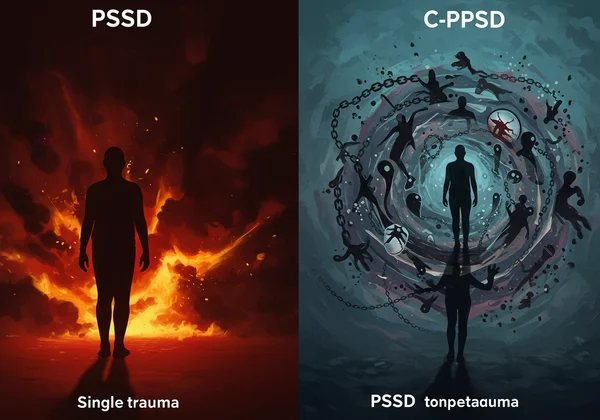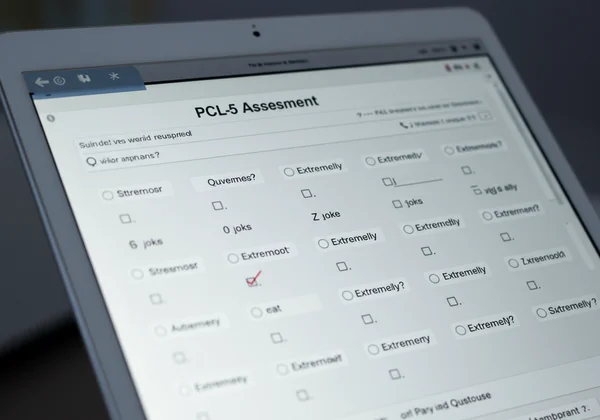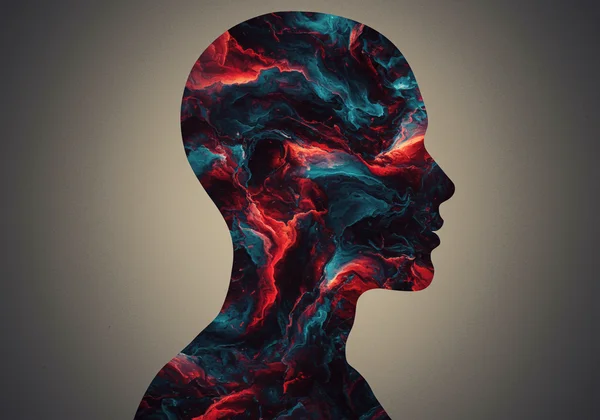创伤后应激障碍(PTSD)与复杂性创伤后应激障碍(C-PTSD):理解创伤与 PCL5 相关性
您是否曾觉得创伤后应激障碍(PTSD)的描述未能完全捕捉到您经历的深度?如果您曾遭受过长期或反复的创伤,您可能正在经历复杂性创伤后应激障碍(C-PTSD)。理解这两者之间的区别,是获得认同和开启康复之旅的关键一步。想了解 C-PTSD 与 PTSD 的区别吗? 本指南将阐明关键差异,探讨症状的重叠之处,并展示像 PCL5 这样的筛查工具如何为您理解您的独特经历提供有价值的起点。
阅读时,请记住,获得清晰的认识是第一步。评估可以为您提供关于创伤如何影响您的初步见解。您可以在准备好后 开始您的评估。

什么是复杂性创伤后应激障碍(C-PTSD)?
复杂性创伤后应激障碍(C-PTSD)是一种可能源于慢性、反复发生的创伤性经历的疾病,这些经历通常发生在难以或不可能逃脱的情况下。与单一事件创伤不同,C-PTSD根源于对令人痛苦的事件的长期暴露。
复杂性创伤的起源:超越单一事件
C-PTSD建立在 复杂性创伤 的基础上——即长期的创伤性经历,尤其是在关键发育时期发生的经历。例如,持续的儿童时期身体或情感虐待、长期的家庭暴力、成为战俘或长期生活在饱受战争蹂躏的地区。关键因素在于创伤的重复性,它系统性地侵蚀了一个人的安全感、自我价值感和对他人的信任。这种持续的压力从根本上塑造了个人的发展和世界观,其方式可能与单一创伤事件不同。
复杂性创伤的关键诊断特征
虽然C-PTSD包含我们接下来将要讨论的核心PTSD症状,但它还具有三个额外的类别,称为自我组织紊乱:
- 情绪调节困难: 这包括持续难以管理情绪。它可能表现为强烈的愤怒、压倒性的悲伤、情绪麻木或感觉无法控制的快速情绪波动。
- 自我概念紊乱: C-PTSD患者通常难以形成积极的自我认知。他们可能带有深刻的无价值感、羞耻感和内疚感,认为自己根本上有缺陷或应为创伤负责。
- 人际关系困难: 维持健康的人际关系通常是一个重大挑战。这可能源于根深蒂固的不信任他人、害怕亲密关系或形成不健康或再次创伤性关系的模式。
理解 PTSD:回顾
创伤后应激障碍(PTSD)是一种有据可查的心理健康状况,可能发生在经历或目睹可怕事件之后,并且有特定的诊断标准。
PTSD 的核心症状群(DSM-5 标准)
《精神疾病诊断与统计手册》第五版(DSM-5)为PTSD概述了四个主要的症状群。这些是专业评估所寻找的具体指标:
- 闯入性症状: 挥之不去、令人不安的记忆、噩梦或闪回,感觉事件再次发生。
- 回避行为: 积极回避创伤的提醒物,包括可能唤起事件的人、地点、活动或想法。
- 认知和情绪的负面改变: 对自己或世界的扭曲信念,持续的负面情绪如恐惧或愤怒,感到与他人疏远,或无法体验积极情绪。
- 唤起和反应性改变: 易怒、发脾气、鲁莽行为、容易受惊吓,或注意力不集中和睡眠困难。
PCL5 如何衡量 PTSD 症状
PCL5 评估 是一项20个问题的自我报告测量,专门用于评估PTSD的这四个核心症状群。 PCL5问卷 上的每个问题都直接对应DSM-5的一个症状。通过对过去一个月每个症状困扰程度的评分,该工具会生成一个严重程度分数。这个分数提供了您当前PTSD症状水平的快照,对于任何想知道自己的经历是否符合官方标准的人来说,它是一个相关的初步步骤。

C-PTSD vs. PTSD:剖析关键差异
核心区别不仅在于症状,更在于它们对您身份的深刻影响。PTSD通常关注单一事件后的特定记忆和恐惧,而C-PTSD则是一种对您的自我感知和人际交往能力的深刻伤害,这种伤害是在长期的创伤环境中形成的。
对自我认知和人际关系的影响
PTSD会给人际关系带来压力并影响情绪,但在C-PTSD中,损害通常更深刻,并且与身份认同有关。创伤的慢性性质已融入个人的存在。这种对 自我认知 的深刻影响导致了普遍的“破碎”或“不配”的感觉。因此,建立牢固的依恋关系可能变得几乎不可能,因为对他人的基本信任已在一次又一次的经历中被粉碎。患有C-PTSD的人不仅感到不安全,他们常常感到在自己内心深处也不安全。
情绪失调及其表现
PTSD中的过度警觉(如容易受惊)是一个常见症状。然而,C-PTSD中的 情绪失调 则更为广泛。它不仅仅是保持警惕;它是一种根本上难以管理人类全部情感范围的困难。一个小的挫折可能会引发一场情绪风暴,其强度与事件本身完全不成比例。这种内在的混乱可能是C-PTSD最使人衰弱的方面之一,使得日常生活感觉像是在不断努力寻求情绪稳定。

重叠之处:两者如何在 PCL5 中呈现
这是一个关键点:患有C-PTSD的人几乎肯定会经历PTSD的所有核心症状。因此,当他们进行PCL5测试时,很可能会得到高分。这并不意味着测试不准确;而是它正确地识别了显著的创伤相关痛苦。PCL5可以作为一个有力的指标,表明存在问题,需要专业帮助。虽然它无法捕捉到C-PTSD特有的症状,如情绪失调或负面自我概念,但高分 PCL5分数 是进一步寻求专业人士评估的明确信号。
童年创伤的持久影响
我们对C-PTSD的许多了解都与 童年创伤 的深远影响有关。当创伤发生在成长关键时期,它会在多个层面扰乱健康的成长。
早期逆境与发育后果
大脑会根据环境进行发育。一个充满恐惧、忽视或虐待的童年会教会大脑,世界是一个危险的地方。这可能导致长期的 发育后果,影响从应激反应系统、情绪调节到建立健康依恋关系的能力的一切。这些早期经历为C-PTSD在成年期所体现的根深蒂固的身份和人际关系困境奠定了基础。

从复杂性创伤中康复:康复之路
尽管伤痕累累,但从C-PTSD中康复是完全可能的。这个旅程通常需要专门的、创伤知情的疗法,这些疗法不仅要处理创伤记忆,还要帮助重建自我意识,并学习情绪调节和健康人际关系的技能。诸如眼动脱敏再加工疗法(EMDR)、躯体体验疗法(Somatic Experiencing)和辩证行为疗法(DBT)等疗法已显示出巨大的潜力。任何康复之路的第一步都是理解。认识到自己的症状是一种自我关怀的行为,可以赋予您力量,让您 踏上康复之旅。
探索您的理解与康复之路
区分C-PTSD和PTSD不仅仅是学术上的练习;它关乎为您的经历找到正确的语言,以及为康复找到正确的道路。PTSD是对创伤事件的反应,而C-PTSD是一种塑造个人自我认知的发育性损伤。
PCL5 是一个易于访问且保密的起点。它可以帮助您量化您正在经历的核心创伤症状,提供一个清晰客观的痛苦程度衡量。这个初步步骤可以提供所需的认同感和清晰度,从而寻求进一步的支持。
如果您想了解过去的经历如何影响您今天的状态,请考虑迈出下一步。您可以在我们的主页上 进行免费测试,立即获得保密的PCL5分数。对于寻求更深入理解的人,我们还提供可选的AI驱动报告,提供关于您独特症状特征、优势和挑战的个性化见解。
关于 C-PTSD、PTSD 和 PCL5 的常见问题解答
C-PTSD 与标准 PTSD 有何具体区别?
核心区别在于创伤的性质和症状的广度。PTSD通常发生在单一事件之后,症状集中在重现、回避和过度警觉。C-PTSD源于长期创伤,并在标准PTSD症状的基础上增加了严重的情绪调节、人际关系和负面自我概念方面的困难。
PCL5 能否准确筛查 C-PTSD 症状?
PCL5旨在筛查DSM-5列出的20种PTSD症状。由于C-PTSD包含了PTSD的所有症状,因此PCL5的高分是需要进一步评估的显著的创伤相关痛苦的有力指标。然而,它不能衡量额外的C-PTSD特有症状,因此应被视为一个起点,而不是C-PTSD的完整图景。
与复杂性创伤相关的最常见症状是什么?
除了标准的PTSD症状外,复杂性创伤特有的最常见症状包括慢性情绪失调(例如,爆发性愤怒、持续的悲伤)、普遍的无价值感或羞耻感、感觉永久受损,以及在建立和维持健康人际关系方面的严重、持续困难。
什么是高 PCL5 分数,它与 C-PTSD 有何关系?
PCL5分数31-33通常被认为是临床显著PTSD症状的初步界限。对于C-PTSD患者来说,高分证实了核心PTSD症状群的存在并导致了严重的痛苦。它证明了创伤正在产生重大影响,并且强烈建议与心理健康专业人士进行全面评估。
PCL5 可以诊断 PTSD 或 C-PTSD 吗?
不,重要的是要理解PCL5是一个筛查工具,而不是诊断工具。它能够可靠地衡量症状严重程度,但不能提供临床诊断。只有合格的心理健康专业人士,如心理学家或精神科医生,在进行全面评估后才能正式诊断PTSD或C-PTSD。您可以 探索评估 以获得可与提供者分享的个人见解。